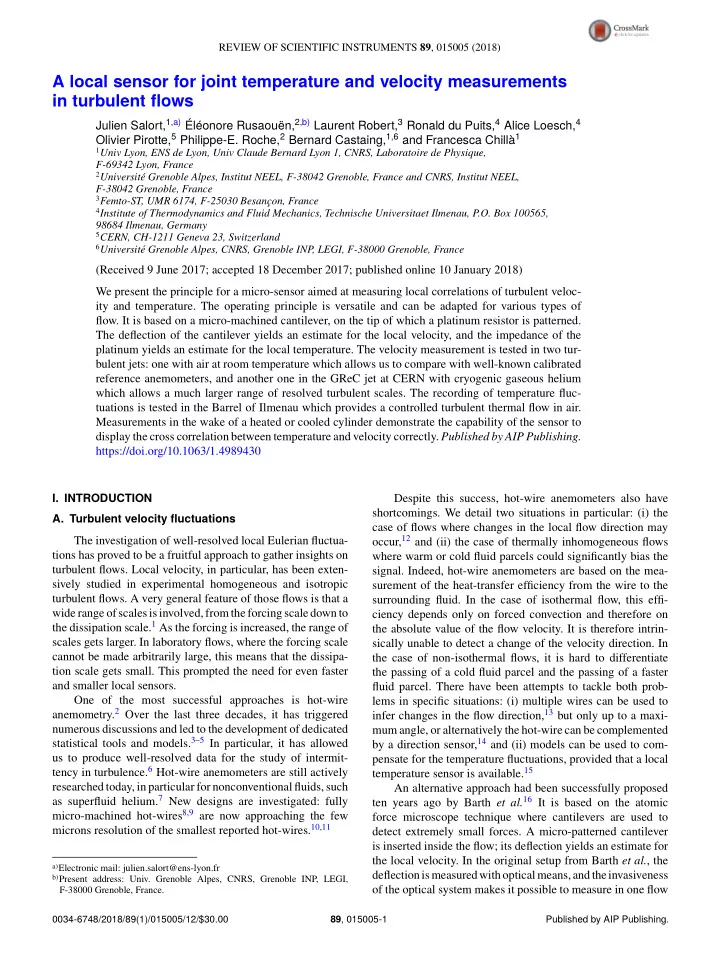

REVIEW OF SCIENTIFIC INSTRUMENTS 89 , 015005 (2018) A local sensor for joint temperature and velocity measurements in turbulent flows Julien Salort, 1,a) ´ en, 2,b) Laurent Robert, 3 Ronald du Puits, 4 Alice Loesch, 4 El´ eonore Rusaou¨ Olivier Pirotte, 5 Philippe-E. Roche, 2 Bernard Castaing, 1,6 and Francesca Chill` a 1 1 Univ Lyon, ENS de Lyon, Univ Claude Bernard Lyon 1, CNRS, Laboratoire de Physique, F-69342 Lyon, France 2 Universit´ e Grenoble Alpes, Institut NEEL, F-38042 Grenoble, France and CNRS, Institut NEEL, F-38042 Grenoble, France 3 Femto-ST, UMR 6174, F-25030 Besanc ¸on, France 4 Institute of Thermodynamics and Fluid Mechanics, Technische Universitaet Ilmenau, P.O. Box 100565, 98684 Ilmenau, Germany 5 CERN, CH-1211 Geneva 23, Switzerland 6 Universit´ e Grenoble Alpes, CNRS, Grenoble INP, LEGI, F-38000 Grenoble, France (Received 9 June 2017; accepted 18 December 2017; published online 10 January 2018) We present the principle for a micro-sensor aimed at measuring local correlations of turbulent veloc- ity and temperature. The operating principle is versatile and can be adapted for various types of flow. It is based on a micro-machined cantilever, on the tip of which a platinum resistor is patterned. The deflection of the cantilever yields an estimate for the local velocity, and the impedance of the platinum yields an estimate for the local temperature. The velocity measurement is tested in two tur- bulent jets: one with air at room temperature which allows us to compare with well-known calibrated reference anemometers, and another one in the GReC jet at CERN with cryogenic gaseous helium which allows a much larger range of resolved turbulent scales. The recording of temperature fluc- tuations is tested in the Barrel of Ilmenau which provides a controlled turbulent thermal flow in air. Measurements in the wake of a heated or cooled cylinder demonstrate the capability of the sensor to display the cross correlation between temperature and velocity correctly. Published by AIP Publishing. https://doi.org/10.1063/1.4989430 Despite this success, hot-wire anemometers also have I. INTRODUCTION shortcomings. We detail two situations in particular: (i) the A. Turbulent velocity fluctuations case of flows where changes in the local flow direction may occur, 12 and (ii) the case of thermally inhomogeneous flows The investigation of well-resolved local Eulerian fluctua- tions has proved to be a fruitful approach to gather insights on where warm or cold fluid parcels could significantly bias the turbulent flows. Local velocity, in particular, has been exten- signal. Indeed, hot-wire anemometers are based on the mea- sively studied in experimental homogeneous and isotropic surement of the heat-transfer efficiency from the wire to the turbulent flows. A very general feature of those flows is that a surrounding fluid. In the case of isothermal flow, this effi- wide range of scales is involved, from the forcing scale down to ciency depends only on forced convection and therefore on the dissipation scale. 1 As the forcing is increased, the range of the absolute value of the flow velocity. It is therefore intrin- scales gets larger. In laboratory flows, where the forcing scale sically unable to detect a change of the velocity direction. In cannot be made arbitrarily large, this means that the dissipa- the case of non-isothermal flows, it is hard to differentiate tion scale gets small. This prompted the need for even faster the passing of a cold fluid parcel and the passing of a faster and smaller local sensors. fluid parcel. There have been attempts to tackle both prob- One of the most successful approaches is hot-wire lems in specific situations: (i) multiple wires can be used to anemometry. 2 Over the last three decades, it has triggered infer changes in the flow direction, 13 but only up to a maxi- numerous discussions and led to the development of dedicated mum angle, or alternatively the hot-wire can be complemented statistical tools and models. 3–5 In particular, it has allowed by a direction sensor, 14 and (ii) models can be used to com- us to produce well-resolved data for the study of intermit- pensate for the temperature fluctuations, provided that a local tency in turbulence. 6 Hot-wire anemometers are still actively temperature sensor is available. 15 researched today, in particular for nonconventional fluids, such An alternative approach had been successfully proposed as superfluid helium. 7 New designs are investigated: fully ten years ago by Barth et al. 16 It is based on the atomic micro-machined hot-wires 8,9 are now approaching the few force microscope technique where cantilevers are used to microns resolution of the smallest reported hot-wires. 10,11 detect extremely small forces. A micro-patterned cantilever is inserted inside the flow; its deflection yields an estimate for the local velocity. In the original setup from Barth et al. , the a) Electronic mail: julien.salort@ens-lyon.fr deflectionismeasuredwithopticalmeans,andtheinvasiveness b) Present address: Univ. Grenoble Alpes, CNRS, Grenoble INP, LEGI, of the optical system makes it possible to measure in one flow F-38000 Grenoble, France. 0034-6748/2018/89(1)/015005/12/ $ 30.00 89 , 015005-1 Published by AIP Publishing.
Recommend
More recommend